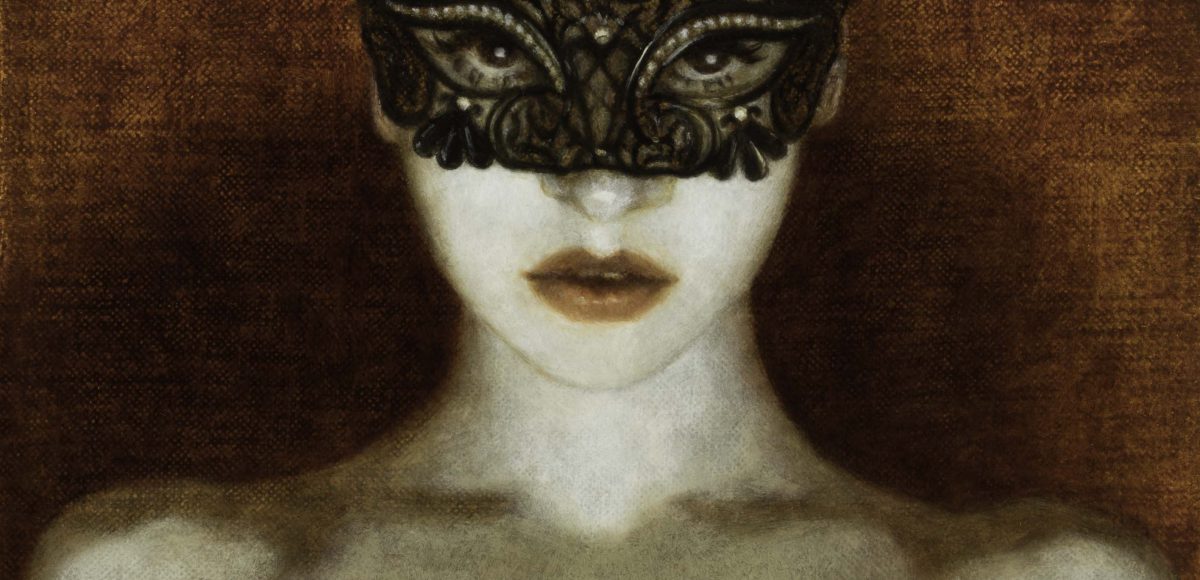With an opening reception scheduled for Friday, Nov. 3rd at La Luz de Jesus in Hollywood, Deirdre Sullivan-Beeman is about to make a profound feminine statement in her exhibition Girls, Girls, Girls. Perhaps now more than ever, it is time to give women their due, and Sullivan-Beeman does so in spades.
The artist attests that this is the era of the girl. “Today’s girl is an emerging phenomenon. What is her secret ingredient? It’s not only about being treated equally, it’s about being strong, present – a ‘wonder woman.’ The powerful femininity arising now is a direct translation of the yin energy that I idolize.”
Sullivan-Beeman says her work comes from a subliminal, magical realm, and indeed the glowing works in the show have a rich, dream-like quality. Self-taught, she is both a figurative and contemporary surrealist artist, combining carefully wrought 14th century painting techniques with images that evoke magical realism.
Her subjects are often child-like, ethereal, and suffused in an elegiac innocence. Her technique is masterful. The thirteen new paintings presented in this exhibition utilize egg tempera with layered oil glaze. Along with the paintings, Sullivan-Beeman will also be presenting a resin sculpture and original drawing of her piece “Turtle Girl.”
 Mask Girl, 2017 © Deirdre Sullivan-Beeman
Mask Girl, 2017 © Deirdre Sullivan-Beeman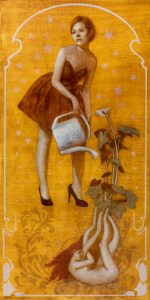 Watering Can Girl, 2017 © Deirdre Sullivan-Beeman
Watering Can Girl, 2017 © Deirdre Sullivan-Beeman I Do Girl, 2017 © Deirdre Sullivan-Beeman
I Do Girl, 2017 © Deirdre Sullivan-Beeman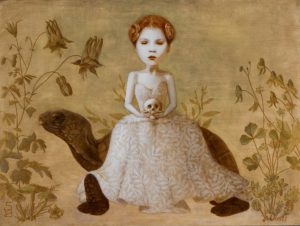 Turtle Girl, 2017 © Deirdre Sullivan-Beeman
Turtle Girl, 2017 © Deirdre Sullivan-Beeman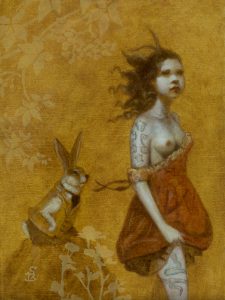 Rabbit Girl, 2017 © Deirdre Sullivan-Beeman
Rabbit Girl, 2017 © Deirdre Sullivan-Beeman Poodle Girl, 2017 © Deirdre Sullivan-Beeman
Poodle Girl, 2017 © Deirdre Sullivan-Beeman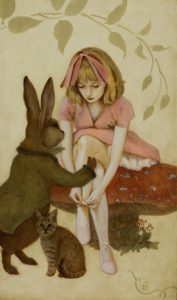 Mushroom Girl, 2017 © Deirdre Sullivan-Beeman
Mushroom Girl, 2017 © Deirdre Sullivan-Beeman Kitten Girl, 2017 © Deirdre Sullivan-Beeman
Kitten Girl, 2017 © Deirdre Sullivan-Beeman Boat Girl, 2017 © Deirdre Sullivan-Beeman
Boat Girl, 2017 © Deirdre Sullivan-Beeman Jellyfish Girl, 2017 © Deirdre Sullivan-Beeman
Jellyfish Girl, 2017 © Deirdre Sullivan-Beeman
The paintings are perfectly, precisely rendered; girls inspired by her personal dream journal, and images of alchemy and tarot. The delicate, haunting subjects appear perfectly suited to the time-consuming technique that the artist uses to create them.
This technique allows Sullivan-Beeman to shape works that seem suffused with an inner light, as if sun were pouring in behind a rather opaque stained glass window. The combination of oil and tempera is unique today – and the artist’s resurrection of a decidedly old-school technique is both reverential and revolutionary, the perfect adjunct to her subjects.
Sullivan-Beeman says she’s been painting in this mix of mediums for ten years.
“The method I use is a method Ernst Fuchs created, called Mischtechnik, as he was trying to replicate the ways the Old Masters painted in the 14th century. Fuchs and his contemporaries are rumored to have used actual biopsies of pieces from painters like Van Eyck to theorize that the Old Masters never painted directly but instead used many layers of oil paint glaze over egg tempera, which is regarded as the first paint,” she explains.
According to Sullivan-Beeman, “When I was first starting to study, I was excited to find the work of those who were embracing these old materials and old techniques – even with their steep learning curves. I was lucky enough to study with the late Robert Venosa, who was a disciple of Fuchs and his contemporaries. I had been seeking a way to create ‘glow’ within my paintings. In practicing Mischtechnik, after layering many thin sheets of oil paint with egg tempera, figures would start to contain internal luminescence. Now, when I turn the lights off and the painting continues to glow, that’s how I know it’s finished. I combine my Mischtechnik practice with a monochromatic palette of warm earth tones.”
Indeed, the autumnal palette is richly, deeply enhanced by that internal glow. It is as if each painting has its own sort of visual “after life,” as with “Poodle Girl,” above.
Or perhaps, what viewers are absorbing is the dream-state in which so much of Sullivan-Beeman’s work gestates.
“I try very hard not to govern my work and to paint directly from my subconscious. Because of that, I believe the political and social realities of the past year have been a subsurface driving force behind much of this body of work. I’m very interested in Jung’s Collective Unconscious, and it seems to me that very palpable stresses and tensions have recently been filling that space.”
The artist notes that her subjects are almost always feminine, although she also includes sweetly genuine depictions of animals. They epitomize both grace and gracefulness.
“The qualities that girls possess and their changing place in our world was a main inspiration these new paintings and their girls, their heroes. The era of the girl is now. She’s very powerful and she’s very alive. She’s not afraid of her individuality. She’s not afraid of her sexuality. She’s only getting tougher and tougher. I hope viewers leave the show with the sense that these girls are a force to be reckoned with.”
That powerful sense is particularly prescient this week and in juxtaposition to the entertainment industry that fuels Los Angeles. Sullivan-Beeman sees these latest works as both an outgrowth and continuation of other elements of her work, but also something entirely new.
“All the work continues to stem from the same place, my subconscious. Each painting continues to – like a dream – represent facets of myself. My subject matter remains girls and their natural environments, their inner demons. With this show, I am trying to expose as many facets of myself as possible. In an unguarded way, I’m painting a complete picture of all the girls within me.”
The artist adds that “The largest piece in the show, “Giant Girl,” is my largest piece to date. Working with egg tempera, I’m constrained to use very tiny brushes. Painting this large was a big challenge for that reason… I truly had to be patient and not fight the process. It became very meditative to carefully construct.”
Sullivan-Beeman looks forward to creating more large-format works in the future, but at any size, her works are both precise, perfect, and writ-large in the language of dreams.
Opening with Sullivan-Beeman at La Luz de Jesus is Jessica Dalva, with Mess, a series of sculptures, drawings and paintings that also draws on the current socio-political culture.
La Luz de Jesus is located at 4633 Hollywood Blvd.; an opening reception will be held Friday, November 3rd from 8 to 11 p.m., the exhibition runs through November 26th.



